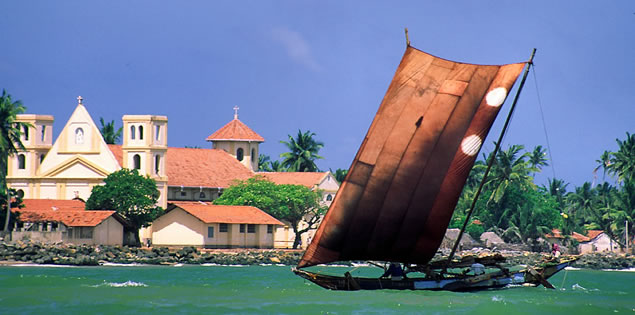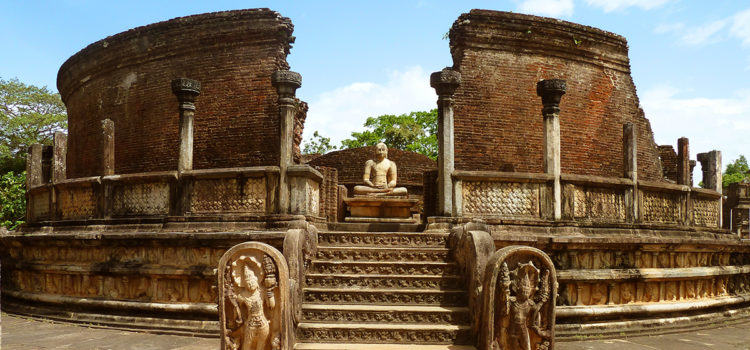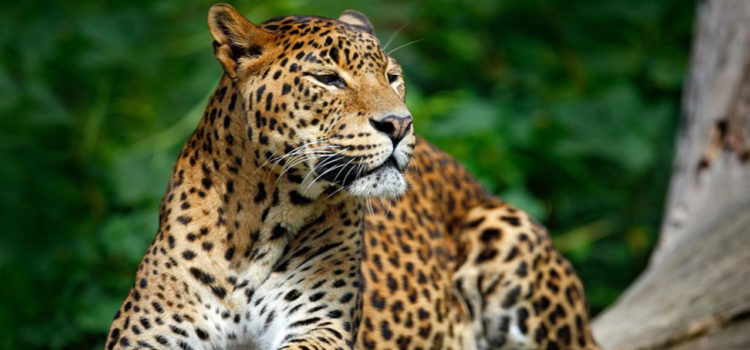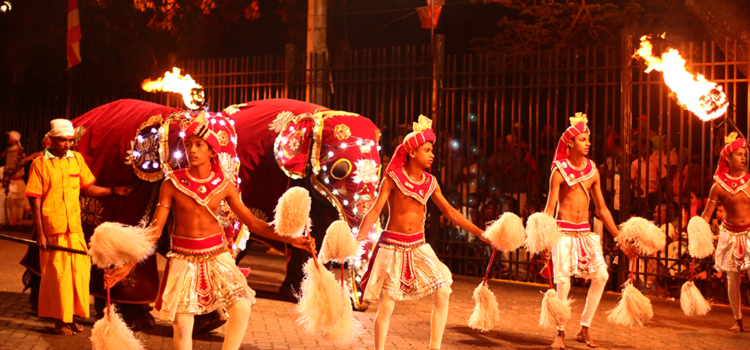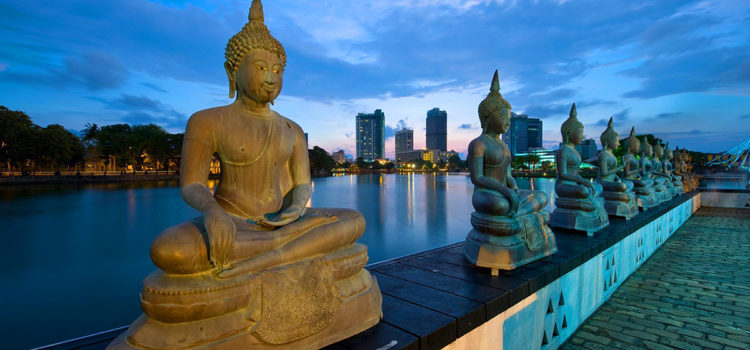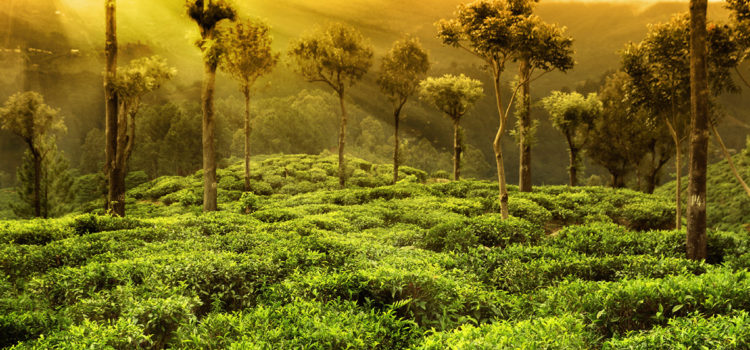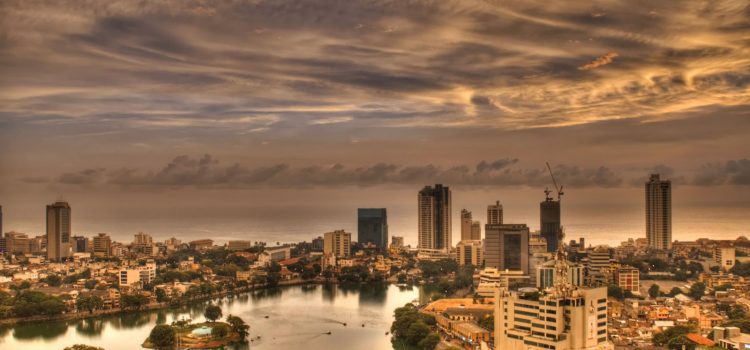Wonder of Asia
Seductive beaches and tempting water sports, magnificent landscapes featuring lazy lagoons, fertile wetlands, ecologically-wondrous types of forest, imposing mountains, bounteous rivers and waterfalls, an abundance of wildlife – much of it endemic – unique ecosystems, inspiring heritage sites from ancient cities to colonial forts, a vibrant culture including fine arts and crafts and grand festivals, and a people of diverse ethnicity and religious persuasion, charming and hospitable.
Contemporary tourist attractions such as luxurious Ayurveda spas and broad-based shopping opportunities have evolved, and Sri Lanka has become one of the world’s most popular destinations to get married and enjoy a honeymoon.
No wonder Sri Lanka is the wonder of Asia.
Gondwanaland and beyond
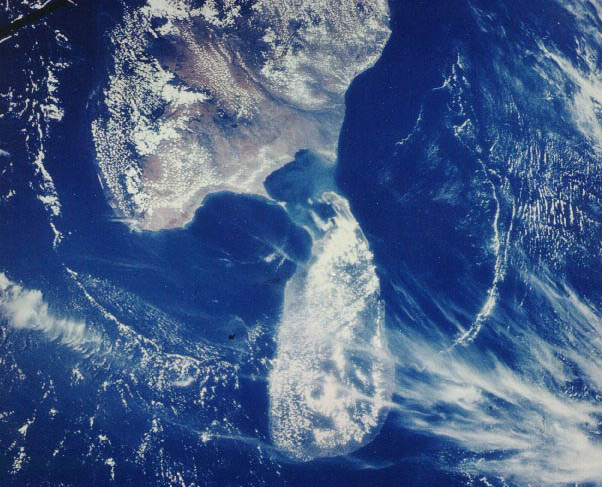
It’s been so since the dawn of time. One hundred and sixty-six million years ago, Sri Lanka was situated far south, nestled next to India and Madagascar in the very centre of the super-continent known as Gondwanaland. India and Sri Lanka, then linked, drifted northwards until this chunk of land impacted with Asia, creating the Himalayas. Later the bridge of limestone shoals that linked Sri Lanka with India mostly submerged, leaving a 30km divide.
Pearl, teardrop, mango
And so was born an island with a distinctive shape, described as “the pearl in the necklace of India”, and likened to a teardrop, mango, pear and even a German type of ham – Westphalian. All these resemblances can be recognized most appealingly in pictures from space. Other likenesses are apparent when areas of the island are isolated: Mannar becomes a perfect dinosaur claw, and the northern peninsula the head of a dugong, an endangered species that inhabits these waters.
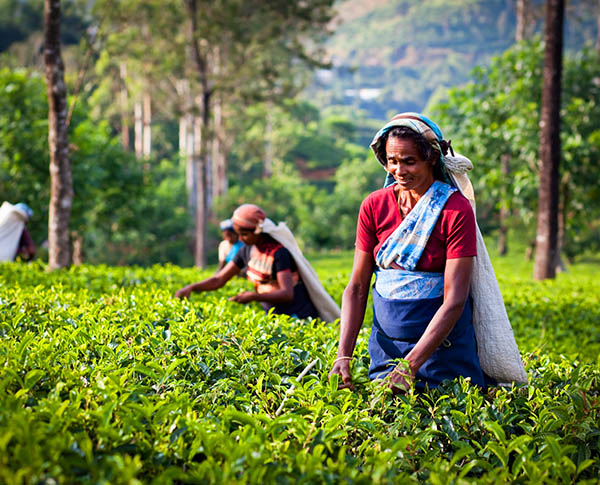
The Stone Age
The human history of this island naturally began with its Stone Age – in thisinstance, remarkably, around 125,000 BC. Artifacts including stone tools unearthed date back several tens of thousands of years. Fifteen thousand years ago, wheat and barley were grown on mountain plateau. Early man appears to have widespread, inhabiting the coast, the plains and the hill country. The Balangoda Manwas unearthed in caves, and the earliest evidence of steel-making in the ancient world, dating to the 3rd c. BC – in England it was the 14th c.AD! – has been found on a hillside where the wind was used to enhance the furnace heat.
The third c. BC was pivotal because of the arrival of Buddhism, which became the basis on which the country’s civilization was structured. Legend has it that in 6th century BC, a certain Prince Vijaya was banished from his Indian kingdom, sailed to Sri Lanka, became the island’s first king and founded the Sinhalese race. The first Sinhalese kingdom developed around the city of Anuradhapura in the 3rd c. BC. From the 5th to the 14th c AD invasions from southern India pushed the capital into remote places before it became established at Kandy. From 1505 to 1948 the island endured another multiplicity – occupancy and degrees of repression and manipulation by no less than three colonial powers, Portugal, Holland and Britain. In 1978, the country became the Democratic Socialist Republic of Sri Lanka.
The People

Sri Lanka is a multi-ethnic, multi-religious and multi-cultural society, a reflection of successive waves of foreign immigrants. The main ethnic groups today are the Sinhalese and Tamils. Then there are Muslims, the Malays and Chinese along with the Dutch Burghers.
Whatever their situation in society, the people of Sri Lanka possess a warm and friendly nature reflected in persistent smiling faces and eagerness to help those unfamiliar with aspects of local life. You’ll find that Sri Lankans are particularly charming and hospitable.
Shopping
The commodity most famously associated with Sri Lanka is tea – or more precisely Ceylon tea. Indeed, the country is the world’s third largest producer of tea. If you wish to purchase the finest, freshest tea – black, green or white – visit an estate and witness how the green leaves are processed to become the product you encounter in the kitchen. Similarly, Sri Lanka’s renowned spices – cinnamon, cardamom, cloves – should be purchased at a spice garden.

Seductive beaches and tempting water sports, magnificent landscapes featuring lazy lagoons, fertile wetlands, ecologically-wondrous types of forest, imposing mountains, bounteous rivers and waterfalls, an abundance of wildlife – much of it endemic – unique ecosystems, inspiring heritage sites from ancient cities to colonial forts, a vibrant culture including fine arts and crafts and grand festivals, and a people of diverse ethnicity and religious persuasion, charming and hospitable.
Contemporary tourist attractions such as luxurious Ayurveda spas and broad-based shopping opportunities have evolved, and Sri Lanka has become one of the world’s most popular destinations to get married and enjoy a honeymoon.
No wonder Sri Lanka is the wonder of Asia.
Gondwanaland and beyond

It’s been so since the dawn of time. One hundred and sixty-six million years ago, Sri Lanka was situated far south, nestled next to India and Madagascar in the very centre of the super-continent known as Gondwanaland. India and Sri Lanka, then linked, drifted northwards until this chunk of land impacted with Asia, creating the Himalayas. Later the bridge of limestone shoals that linked Sri Lanka with India mostly submerged, leaving a 30km divide.
Pearl, teardrop, mango
And so was born an island with a distinctive shape, described as “the pearl in the necklace of India”, and likened to a teardrop, mango, pear and even a German type of ham – Westphalian. All these resemblances can be recognized most appealingly in pictures from space. Other likenesses are apparent when areas of the island are isolated: Mannar becomes a perfect dinosaur claw, and the northern peninsula the head of a dugong, an endangered species that inhabits these waters.

The Stone Age
The human history of this island naturally began with its Stone Age – in this instance, remarkably, around 125,000 BC. Artifacts including stone tools unearthed date back several tens of thousands of years. Fifteen thousand years ago, wheat and barley were grown on the mountains plateau. The eariy man appears to have widespread, inhabiting the coast, the plains and the hill country. The Balangoda Man was unearthed in caves, and the earliest evidence of steel-making in the ancient world, dating to the 3rd c. BC – in England it was the 14th c.AD! – has been found on a hillside where the wind was used to enhance the furnace heat.
The third c. BC was pivotal because of the arrival of Buddhism, which became the basis on which the country’s civilization was structured. Legend has it that in 6th century BC, a certain Prince Vijaya was banished from his Indian kingdom, sailed to Sri Lanka, became the island’s first king and founded the Sinhalese race. The first Sinhalese kingdom developed around the city of Anuradhapura in the 3rd c. BC. From the 5th to the 14th c AD invasions from southern India pushed the capital into remote places before it became established at Kandy. From 1505 to 1948 the island endured another multiplicity – occupancy and degrees of repression and manipulation by no less than three colonial powers, Portugal, Holland and Britain. In 1978, the country became the Democratic Socialist Republic of Sri Lanka.
The People

Sri Lanka is a multi-ethnic, multi-religious and multi-cultural society, a reflection of successive waves of foreign immigrants. The main ethnic groups today are the Sinhalese and Tamils. Then there are Muslims, the Malays and Chinese along with the Dutch Burghers.
Whatever their situation in society, the people of Sri Lanka possess a warm and friendly nature reflected in persistent smiling faces and eagerness to help those unfamiliar with aspects of local life. You’ll find that Sri Lankans are particularly charming and hospitable.
Shopping
The commodity most famously associated with Sri Lanka is tea – or more precisely Ceylon tea. Indeed, the country is the world’s third largest producer of tea. If you wish to purchase the finest, freshest tea – black, green or white – visit an estate and witness how the green leaves are processed to become the product you encounter in the kitchen. Similarly, Sri Lanka’s renowned spices – cinnamon, cardamom, cloves – should be purchased at a spice garden.

Nature & Wildlife
As the sun sinks toward the distant horizon, the elephants begin to emerge from the scrub vegetation and move solemnly toward the water of a lake. It is September, towards the end of the dry season, and most water sources have long since disappeared. The Minneriya tank, however, retains water throughout the parched months and the now-exposed tank bed is flourishing, the fresh growth attracting herds of elephants from near and far.
The gentle, charismatic giants congregate here every year at this time, their numbers sometimes exceeding 300. To see so many together –playing, eating, swimming, looking for mates –is nothing but breathtaking. That this occurs very near to the physical centre of a fairly diminutive, densely-populated and compact island is symbolic of the elephant’s indigenous importance.
The crowded ecological stage
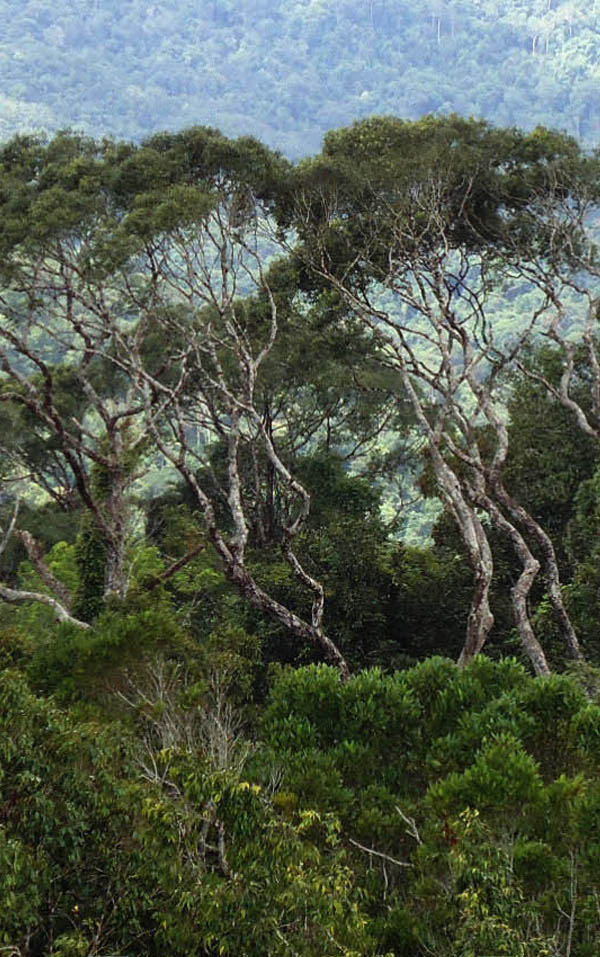
Elephants may be the most celebrated of Sri Lanka’s diverse wildlife, but they actually represent just one actor on a crowded ecological stage. For instance, this is one of the best places in the world to see the elusive leopard, and one of the only places where the big cat is top predator in the system – the king of the Sri Lankan jungle. With striking markings, a sleek, powerful body, and graceful movements, the leopard is thrilling to observe – try Yala National Park in the south-east coastal and zone.
The final member of Sri Lanka’s ‘big three’ is the sloth-bear, a shaggy, shambling denizen of the dry zone forests whose elongated snout and scimitar-like claws are ideally adapted for extracting termites from their mounds. In May and June they take to the trees – a fantastic if incongruous sight! – to feed on the sweet yellow fruits of the palu tree. Wasgamuwa National Park is one of the best places on the island to have the pleasure of a sloth-bear encounter.
As the sun sinks toward the distant horizon, the elephants begin to emerge from the scrub vegetation and move solemnly toward the water of a lake. It is September, towards the end of the dry season, and most water sources have long since disappeared. The Minneriya tank, however, retains water throughout the parched months and the now-exposed tank bed is flourishing, the fresh growth attracting herds of elephants from near and far.
The gentle, charismatic giants congregate here every year at this time, their numbers sometimes exceeding 300. To see so many together –playing, eating, swimming, looking for mates –is nothing but breathtaking. That this occurs very near to the physical centre of a fairly diminutive, densely-populated and compact island is symbolic of the elephant’s indigenous importance.
The crowded ecological stage

Elephants may be the most celebrated of Sri Lanka’s diverse wildlife, but they actually represent just one actor on a crowded ecological stage. For instance, this is one of the best places in the world to see the elusive leopard, and one of the only places where the big cat is top predator in the system – the king of the Sri Lankan jungle. With striking markings, a sleek, powerful body, and graceful movements, the leopard is thrilling to observe – try Yala National Park in the south-east coastal and zone.
The final member of Sri Lanka’s ‘big three’ is the sloth-bear, a shaggy, shambling denizen of the dry zone forests whose elongated snout and scimitar-like claws are ideally adapted for extracting termites from their mounds. In May and June they take to the trees – a fantastic if incongruous sight! – to feed on the sweet yellow fruits of the palu tree. Wasgamuwa National Park is one of the best places on the island to have the pleasure of a sloth-bear encounter.
Furry, scaled and feathered creatures
Sri Lanka’s varied forests abound with a dizzying assortment of other furry, scaled and feathered creatures. There are five species of deer, ranging from the diminutive mouse deer – just 30cm in height and armed with elongated canine teeth – to the sambar, a large, stately species in which the bull grows impressively large antlers. The latter are best seen in the high, open area surrounding Horton Plains,where they gather in the crisp evenings to feed on the long grasses – and gain protection in numbers from leopards on the stalk.
Civets, mongooses, porcupines and three species of small cats roam the forest floor, while up in the trees primates reign. The widely – spread toque macaque is an archetypal monkey – active, acrobatic and not a little mischievous in Polonnaruwa they live among the ruins of ancient temples and palaces, where the young gambol on stone walls 1,000-years old. Grey langurs, members of the tribe of the monkey-god Hanuman of the Hindu epic poem, the Ramayana, inhabit the dry lowlands and are often to be seen in large troops, pigeon-toed as they cross open ground, their long tails held partially erect in unintentional mimicry of a question-mark.
Often heard reverberating across the forested upper slopes of the central hills in the early morning is the booming call of the ‘bear’ monkey, a sub-species of the purple-faced langur, whose name derives from its shaggy bulk. The loris, smallest of the island’s primates, is also the most unusual, an enigmatic nocturnal hunter with spindly legs and large, luminous eyes. It possesses a unique, high-pitched call that pierces the stillness of the tropical night, sending shivers down the spine.
Even more evocative is the blood –curdling shriek of the Spot-bellied Forest Eagle Owl, locally known as the ulama or “devil-bird”. This is the largest and one of the rarest of Sri Lanka’s dozen owl species and part of a rich avifaunal community of 482 species that are either residents or visitors to the island, including 33 endemic species (as an island, Sri Lanka is home to numerous endemic species that evolved in isolation from mainland populations and thus developed their own distinctive characteristics).
Sri Lanka’s birdlife is astonishing, which is why ornithologists and amateur bird watchers worldwide flock here to take in such dazzling encounters as a flamboyant peacock strutting like a courtier, trying to impress the hens with his upright shimmering tail feathers, and a White-bellied Sea Eagle swooping from his perch on a half-submerged tree, diving low over an inland tank to pluck a fish from the glittering water. And not forgetting a Sri Lankan Paradise Flycatcher flitting from perch to perch its amazingly long tail feathers bobbing behind it like a chestnut ribbon.
Hornbills are seen nesting in hollowed tree trunks, completely sealed in except for a small hole sufficient only for their partners to insert food while noisy flocks of parakeets speckle the blue sky green. In Sinharaja Forest Reserve and other wet Zone forests, mixed feeding flocks feature prominently, with many species travelling together through the forest plucking insects from the air, pulling grubs from tree-trunks and sipping nectar from flowers.
On a similar scale, the island abounds with a wonderful diversity of creatures seen from the comfort of a poolside lounger or as one strolls through town. Butterflies dip and flutter on delicate wings vibrantly hued to draw attention or painted in more muted tones to deflect the same. Gaudy dragonflies hover on rigid, translucent wings while ethereal damselflies dance amid the foliage. Spiders, like tine gemstones, wait patiently in gauzy webs that shimmer, dew-drenched in the early morning sunshine.
The underwater world is kaleidoscopic array
On a breezy, tropical night, the coastline, illuminated by the light of the full moon, a small section on of a beach begins to gently quiver. Suddenly, from amid the shifting grains of sand, emerges first one, then another and another tiny black form, and their curved carapaces glinting softly.
These creatures are the leatherback sea turtle hatchlings, perfect miniature replicas of their parents, which immediately scuttle down the beach towards the sea, so beginning a remarkable battle for survival that, like the island upon whose shores they begin life, represents a perfect blend of ocean and land, water and earth.
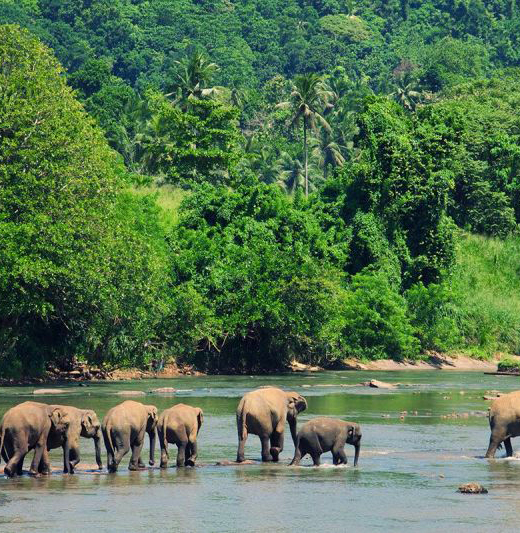
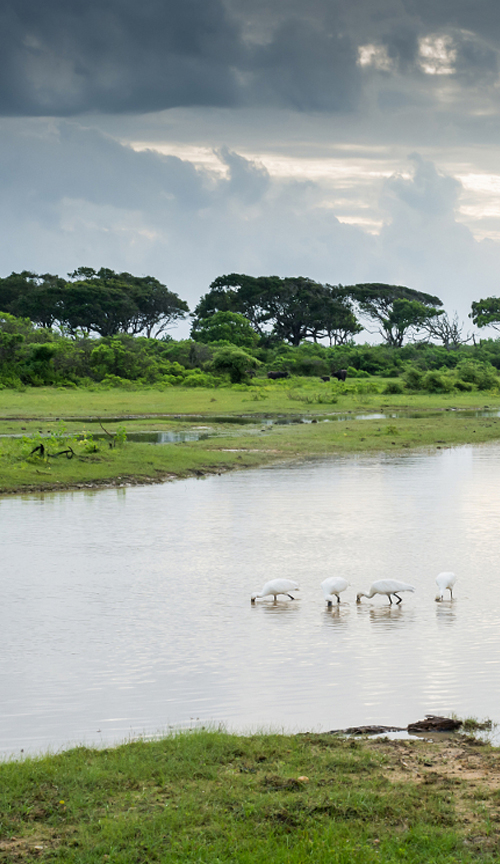
Further out from shore the wildlife diversity is no less extraordinary. The underwater world is a kaleidoscopic array of fish and coral. Electric blues, incandescent purples, radiant yellows and everything in between can be seen in deep sea caves, hovering around ancient sunken wrecks and on sheer rock walls that drop into the endless blue depths. This treasure trove of life can be visited throughout the year since the conditions are always ideal on at least one of the coasts!
Above the waterline whales breach the surface, offering tantalizing glimpses or longer, lingering views. To share into the eye of one of these mysterious, huge animals, regarding it as it regards to you, is to look back to the beginning of time. Blue whales, the largest animal on the planet, are seen off south coast Mirissa from November to May, as are Humpback and sperm whales, while on the north-west coast, off the Kalpitiya peninsula, dolphins by the score cut through the brilliant blue sea, leaping, spinning, frolicking – and even allowing lucky onlookers to share the warm waters with them.
Sand dune to cloud forest, tree frog to elephant
Sri Lanka is like a children’s story book creation: palm-fringed beaches ring a heavily-forested interior, which in turn rises majestically to form a rugged, mountainous core. Monsoon winds lash this island twice a year, the orientation and the rains they bring are responsible for determining the eco-regions that characterize the island.
Most of the broad lowland plain is the dry zone, with tall monsoonal evergreen forests composed of a canopy overarched with magnificent emergent trees. Despite the relative scarcity of water this dry zone harbours a surprisingly large complement of wildlife.
Notable among them are large mammals in the south-east and shorebirds in both regions – the latter flock here to forage in the rich tidal shallows and salty lagoons. In the south-west, the rains nurture some of the finest lowland tropical rainforest in Asia. Sinharaja Forest Reserve – a UNESCO World Heritage Site – encompasses the largest single swath of remaining lowland tropical rainforest in the country and rewards visitors with differing hiking trails alive with butterflies, birds and lizards, and rocky viewpoints offering spectacular forest vistas.

Climbing up into the central highlands, the slopes not carpeted with emerald fields of tea are instead blanketed with thick sub-montane forest that gives way to stunted montane forests above 1,500m. Waterfalls are numerous here.. Mosses, lichens and ferns – including some above head-height – proliferate here, as does an abundance of flowering plants including orchids.
One of the most remarkable aspects of this biological cornucopia – sand dune to cloud forest, tree frog to elephant – is the accessibility of it all. All ecological zones and the bounteous wildlife that inhabit in them can be comfortably experienced in a week.
There are 12 National Parks on the island and 52 Sanctuaries, which together account for over 12% of Sri Lanka’s land area, so visitors are not restricted to a few over-visited locations. For an island of such modest size, Sri Lanka is blessed with a truly startling diversity of forests and wildlife. This ecological jewel is a nature lover’s paradise that offers truly a wonderful experience.
Aurveda In Sri Lanka
Sri Lanka has always been a place that refreshes not just the mind and body, but also the soul and spirit. And for thousands of years, the most popular method used to restore and rejuvenate tired bodies and weary souls has been Ayurveda- the oldest and most holistic medical system available in the world. Based on indigenous native and Indian medicine, it draws not only on a deep understanding of physiology, but also elements of philosophy, psychology and spirituality. It was so influential that traditional Tibetan Chinese medicine and Greek medicine embraced many of the concepts introduced by Ayurveda.
According to legends in the 6th century BC, the Prince Vijaya was banished from his Indian kingdom, sailed to Sri Lanka and become the island’s main ruler. He was skilled in the practice of Ayurveda and so, together with his personal physician, introduced the practice of Ayurveda to the island. Over the years, Ayurveda incorporated elements from similar indigenous Sri Lankan treatments to become the fusion of forms it is today.
More Ayurvedic practitioners than Western doctors
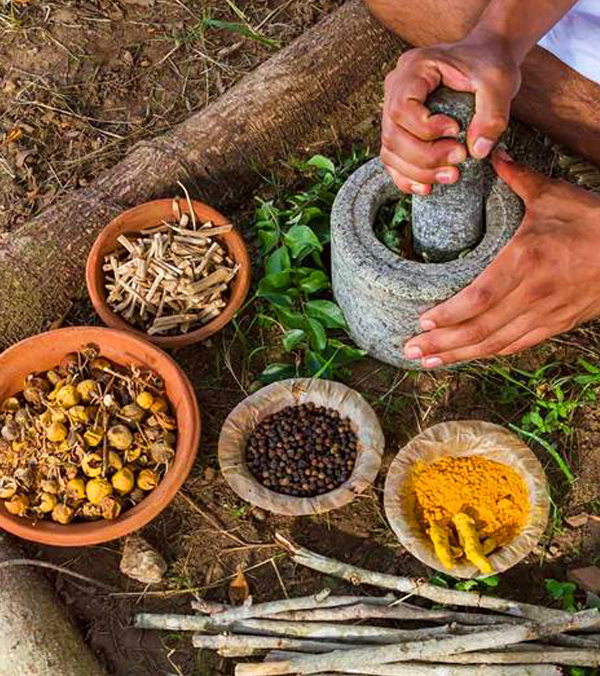
In Sri Lanka’s villages, Ayurveda is not considered a special treatment as in urban areas but an everyday method of treating aches and pains. In fact, the number of trained Ayurvedic practitioners in the island exceeds that of Western doctors.
Even those familiar with traditional spa treatments in the West (like aromatherapy and shiatsu) will find Ayurveda a new experience. And it’s an experience that’s becoming increasingly sought after. Such seekers will find Sri Lanka a singular destination, for all that collective wisdom regarding Ayurveda can be experienced in stylish and refined spas, with some of the world’s best professional therapists – with that friendly and courteous Sri Lankan manner.
Ayurveda – “The Science of Life”
The name comes from ancient Sanskrit: Ayuh or “life” and Veda or “Science”. So Ayurveda translates as “The Science of Life,” a fitting name for a system that devotes itself to a truly holistic approach to the ways the body and mind can be treated.
At the heart of Ayurveda is the theory of the Tri Dosha or “The Three Vital Forces”: Vata (wind), Pita (fire) AND Kapha(earth). In each of us is a unique combination of these forces or Doshas that help define our nature. Vata people are thin and energetic; Pita people are more intense and goal-oriented, while those with a Kapha disposition are methodical and nurturing.

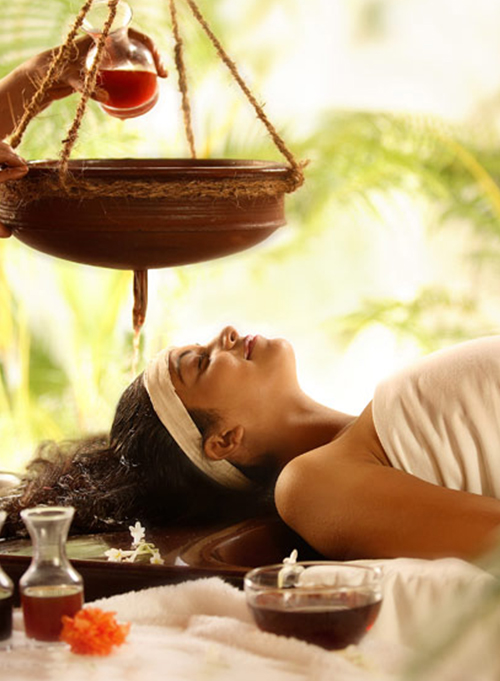
When the Doshas are in harmony the body is in good health, but when equilibrium is affected, balance needs to be restored –Ayurveda provides the answer. Ayurvedic practitioners will initially meet you with the objective of getting to the root of whatever is ailing you. Details of your diet and lifestyle, your habits (good and bad), and your general environment, will be requested. The practitioners will also carry out a physical examination and find out details of your medical history.
Practitioners employ many of the medical herbs and plants native to Sri Lanka. They combine leaves, bark, berries, roots and flowers to created bespoke potions, oils and unguents tailor-made for the individual. Incidentally, in Ayurveda there is a belief that it’s not just people but also plants that can get sick – so only “healthy” plants are used.
Swedhana, Pizhichil & Shirodhara
Inside the tranquil settings of the spa, therapists will help you decide, which of the range of therapies to adopt.
In Swedhana you are placed in, or on, a wooden chest in which herbs are boiled and the resulting steam escaping through perforations embraces your body, helping to extricate impurities.
Pizhichil is somewhat different, consisting of a relaxing massage – sometimes using two therapists – in which soothing oils are rubbed into your joints.
Another treatment is Shirodhara (“Third Eye Drip”), in which oils and other liquids are gently poured from a special vessel onto the ‘third eye’ on your forehead for 30 minutes. Profoundly relaxing, this treatment is used for conditions such as headaches and mental tension.
Later you can indulge in a flower bath, in which you lie submerged in a warm pool of blossoms, scented with fragrant flowers and sandalwood – an experience designed to reset your body as it prepares to return to the real world.
Other treatments which can be added at the discretion of your therapist include:
- Gandusha (herbal gargling)
- Akshitarpana (eye-care)
- Karnapurna (ear-care)
- Shirovasthi (head oil treatment)
- Kativasthi (back oil treatment)
Classification of food
Since Ayurveda is concerned with treating the inside as well as the outside of the human body, you can also try Sri Lanka’s delicious foods prepared in an Ayurvedic manner, which are grown in the field, freshly harvested, and prepared using authentic herbs and spices sourced locally.
In Ayurveda, food is classified into six taste categories: sweet, sour, salty, bitter, pungent and astringent.
Ayurvedic philosophy recommends you have these categories in every meal to achieve the proper nutritional balance. As important as the right mix of ingredients is the proportions: over-eating or eating before the previous meal has been digested is liable to cause an imbalance in the Doshas. Eating in moderation and at the correct time is central to the proper fulfillment of an Ayurvedic diet.
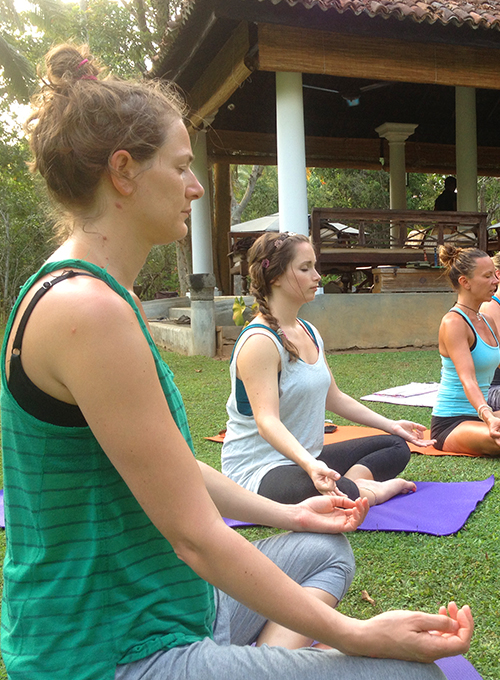
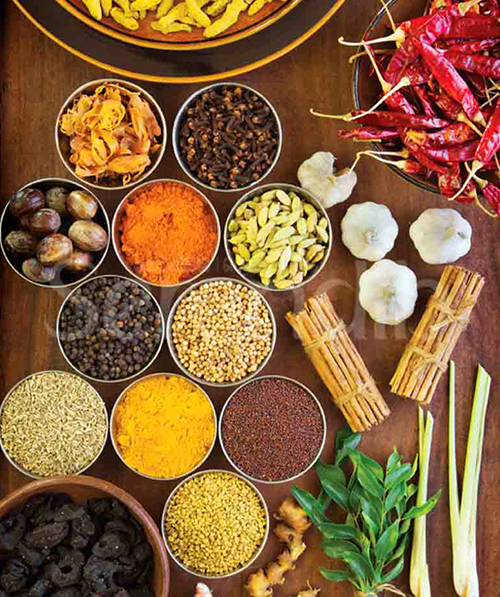
Useful on day-to-day basis learning about various methods – nutritional, physical or spiritual – you can take home and adopt in your everyday life. After all, it would not be true to the holistic nature of Ayurveda if the benefits were to stop after your holiday ended.
Before your return, why not purchase some Ayurvedic products?
Uduwarthana powder contains white sandalwood, turmeric and venivil leaves: when blended with milk it makes an excellent facial treatment.
Ksharabala, on the other hand, is oil used for treating nervous disorders from the entire babilaplant and over 40 additional medicinal herbs.
Many Sri Lankan Ayurvedic centres offer complementary therapies, such as yoga, reflexology and meditation, under the tuition of highly trained therapists. This will enable you to put together a bespoke treatment course. So a visit to an Ayurvedic spa may not just allow you to leave Sri Lanka feeling healthy and relaxed – but spiritually rejuvenated as well – truly a wonderful experience indeed.
What’s more, you can enjoy the pleasures of an Ayurvedic spa in some of the most tranquil and serene settings in Sri Lanka – on a golden south coast beach, near the ancient city of Polonnaruwa, the verdant hill country of Kandy, and even in a traditional village setting with no electricity, and mud huts for accommodation.
When you finally emerge from such exotic settings feeling refreshed and uplifted, you’ll understand you’ve learnt something truly profound through your experience with The Science of Life.
Beaches
Toes curling into the finest sand.
The aquamarine blue waves of the Indian Ocean gently unfolding on the golden shore.
A fresh coconut sipped in the shade of wind-whispering palms.
A (not- too- long) bask in the early morning or late afternoon sun.
A cool-off in the vast expanse of sun-glittering sea.
Some of the delights of Sri Lankan beach.
Where beaches are concerned you will be spoilt for choice in Sri Lanka. Beaches totaling 1,350km fringe the island, from the long-established tourist destinations of the southern coast, to the vast beaches of the deep south, and the less-visited expanses of the north and east. No matter what time of the year, you can find a beach that is in season and just waiting to welcome you to its warm sands.
The southern coast
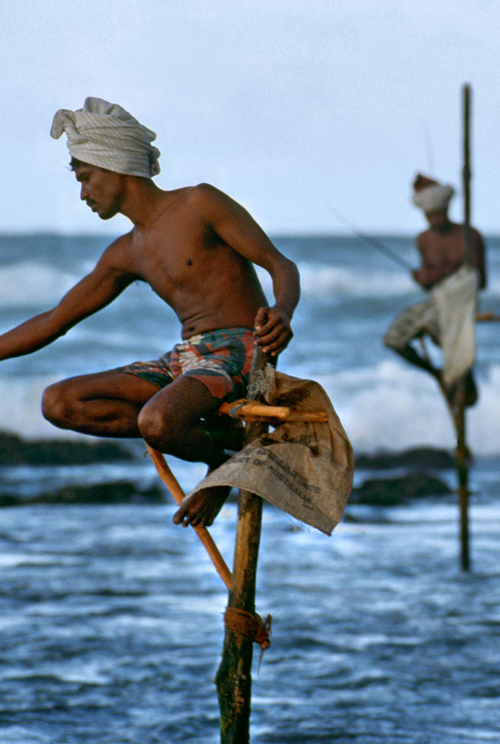
Most visitors to Sri Lanka head to the beach destinations of the southern coast, mostly situated south of Colombo. Each destination has developed its own distinctive character and highlights, and all are within easy reach of the capital. Let’s start with Negombo (37km from Colombo), situated only 6km from the Bandaranaike International Airport and therefore an excellent option for those on a short trip to the island or restricted to Colombo. The town has a long history of tourism and a wide beach, but also tempts the visitor with Dutch canal boat tours, a colourful fish market, and lively bars after dark. Equally convenient for those visiting the capital is Mount Lavinia beach – a mere 12km south of the city centre. The beach is a great place to stroll in the evening and on holidays, and enjoy dining at one of the many and varied restaurants. Recently it has become a night-time destination for some of the most high profile parties in Colombo.
Moving down the coast, the visitor leaves the urban sprawl and begins to sense the more relaxed nature of the south-west coast. Wadduwa (35km from Colombo) is a favourite weekend destination for many Colombo dwellers and features one of the most beautiful hotels on the coast.
Kalutara (42km from Colombo) hosts a number of star-class hotels, another typically stunning beach, and also a majestic three-storey Buddhist temple, which has the world’s only hollow stupa. The road finally joins the coastline after crossing the railway tracks at Payagala and from this point onwards you are treated to a stunning drive overlooking cove after cove of pristine beach.
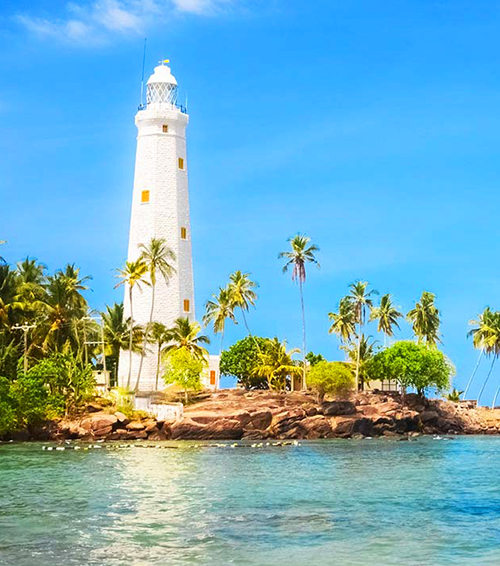
Bentota (62km from Colombo) remains one of the most delightful beach resorts of this coast with large star-class hotels, exclusive boutiques, and even the delightful gardens of Bevis Bawa – brother of Sri Lanka’s most famous architect. On top of all this, Bentota boasts wide, picturesque beaches, and the Bentota Ganga (river) on which tourists can take a cruise inland or take part in water sports. From Bentota onwards, beaches stretch before the visitor consistently through Induruwa until finally we reach Hikkaduwa (98km from Colombo) – one of the most famous beach resorts in the island. Hikkaduwa is renowned for its diving and coral reef, as well as its surfing and nightlife.
The historic port city of Galle(116km from Colombo) with its UNESCO World Heritage Site – the Dutch Fort – and boutique hotels a little beach. But just south of Galle is the famous beach of Unawatuna (120km from Colombo) which continues to be a favourite of most visitors to Sri Lanka in search of sun, sea and sand. Unawatuna was voted among the top 12 beaches in the world and boasts excellent diving, a relaxed atmosphere and lively nights. Most accommodation here is of the guest-house variety suited to independent travellers. For those looking for luxury accommodation, it would be wise to stay in Galle Fort and visit Unawatuna during the day.
Throughout the stretch of beach from Negombo to Unawatuna there is ample opportunity to take part in water and beach-sports, experience the highest standard of service and accommodation, and yet still be within easy reach of the capital and the airport. The best time to visit the southern beaches is from November to April when the sun shines temptingly while the monsoon is on the east coast.
The deep south
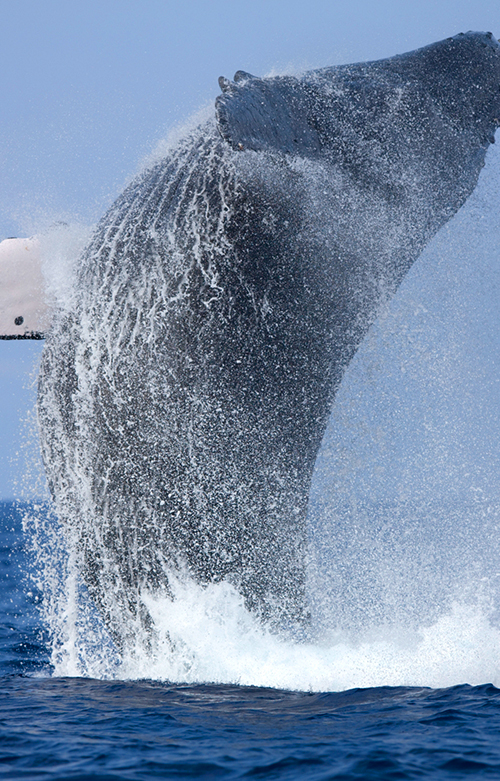
For those who are happy to travel slightly further comes the joy of new discoveries, and of remote beaches in the deep south of Sri Lanka. Weligama bay (143km from Colombo) is simply picturesque, with stilt-fishermen perched out to sea and catamarans gliding by. For those who are looking for something special. Taprobane Island can be waded to from the bay.
Just past Weligama lies Mirissa (155km from Colombo), which many feel is the best beach destination in the deep south as it retains an unspoilt fee land features a beautiful cove. A favourite with surfers, Mirissa is a place for the sporty and laid-back traveller. Finally on this stretch of coastline comes Tangalle (195km from Colombo), which boasts stunning deserted beaches that stretch as far as the eye can see, and the chance to watch turtles at Rekawa, and visit the nearby rock temple of Mulkirigala with its cave paintings and unforgettable views of the countryside.
The east coast
For a truly pristine, unadulterated beach experience, there is no place better than the east coast. Nilaveli and Uppuveli (271km from Colombo) lie to the north of Trincomalee and have for many years provided warm hospitality on stunning wide sandy beaches. Offshore liesPigeon Island – a treat for divers with its vibrant coral gardens and swarms of tropical fish. From here the visitor can also discover hot springs, the fifth largest natural harbour in the world at Trincomalee, and numerous revered Buddhist and Hindu temples.
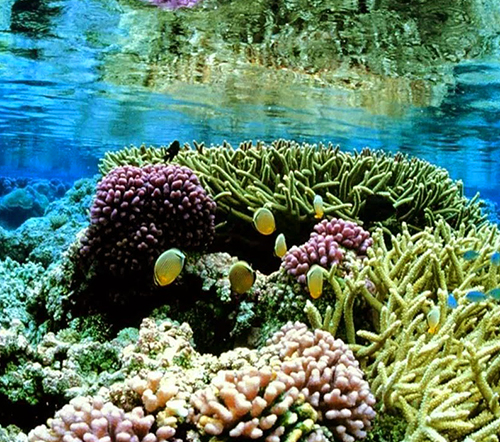
Near Batticaloa are Kalkudah and Pasekudah beaches (346km from Colombo), which are the least –visited on the east coast. Altogether they form 6km of fine sand and calm aquamarine seas that benefit from the protection of an offshore coral reef. Finally, on the east coast is Arugam Bay (314km from Colombo), with its well-established surfing scene and untouched beaches that stretch both to the north and to the south of the town. Close by is the Lahugala National Park, which hosts an array of tropical birdlife and herds of elephants.
The north coast
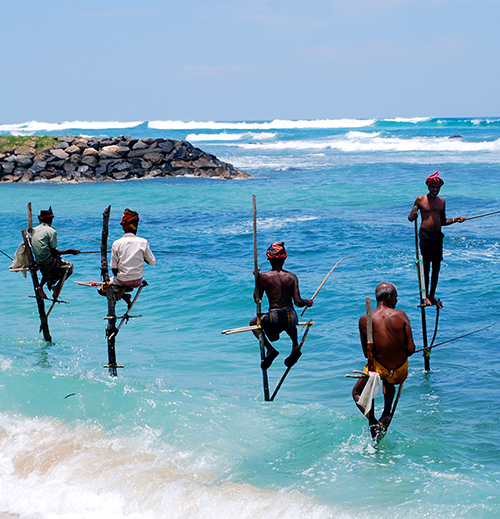
The north of Sri Lanka offers its own distinctive beach experience, with offshore islands dotted around the Jaffna (396km from Colombo) coast, virgin beaches fringed with Palmyrah trees such as the famous shallow transparent waters of Casuarina Beach, and the wild and unforgettable sand dunes of Manalkadu. On the north-west coast of Sri Lanka is Kalpitiya (150km from Colombo)with its pristine beaches and azure sea which plays host to dolphins and whales during the season, and is also home to the famous Bar-Reef – the largest coral reef in Sri Lanka.
The best time of year to visit the pristine north and east coast beaches is from May to September.
Wherever you choose to lay your towel, be sure to take plenty sunscreen and water with you. Even when cloudy, the tropical sun is extremely strong and the wise visitor will either cover up with clothing or with sunscreen. Remember that dehydration can be a major problem if you spend time on a tropical beach. Finally, please respect the beach environment, refrain from littering and don’t buy illegal souvenirs made from corals or turtle shells.
The Deep Blue Adventure
For divers, places to visit are Negombo, Hikkaduwa, Unawatuna, Weligama, Mirissa, Tangalle, Pigeon Island and Bar Reef near Kalpitiya. Not only will you encounter exotic reef fish and some of Sri Lanka’s 138 species of corals, but you have the chance to dive on some of the island’s submerged shipwrecks. If you prefer to remain above water but love sea-life, then there is the chance to go whale and dolphin-watching in Mirissa, Trincomalee and Kalpitiya. For those who like to surf then head for Hikkaduwa and Arugam Bay.
Whether you yearn for a five-star beach resort, a laidback surfer’s paradise or a wreck dive among multi-coloured tropical fish, Sri Lanka has the right beach destination for you. Amazingly, all of these beaches are within a day’s journey of the capital – a journey that reveals many of the different aspects of the island’s physical diversity – all in all, truly a wonderful experience indeed.
Festivals
Sri Lanka’s ancient civilization endows with a legacy of colourful festivals relating to the Buddhist, Hindu, Muslim and Christian religions. Hardly a month goes by without a unique celebration rooted in the island’s tradition. Furthermore, these festivals are commemorated with the flair of people with a genius for pageantry and ritual.
January
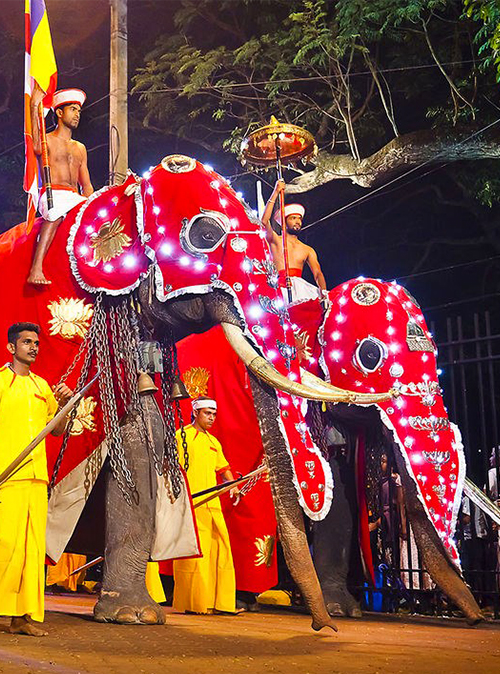
Every full moon day in Sri Lanka is known as Poya a Buddhist public holiday in which adherents dress in white to visit the temple from dawn until dusk to pray, meditate and listen to religious discourse. The 12 Poya days each year are individually named and connected to the events of the life of the Buddha and Buddhism.Duruthu Poya, the initial full moon day of the Gregorian calendar, commemorates the Buddha’s first three visits to Sri Lanka. The Kelaniya Raja Maha Viharaya or Kelaniya Temple, near Colombo, hosts a perahera, literally “procession”, to mark this symbolic event. The perahera is a spectacular aspect of Sri Lanka’s festivals in which an array of traditionally-attired dancers, drummers, whip-crackers, acrobats and enrobed elephants, participate.
For foreign visitors it’s one of Sri Lanka’s most appealing cultural attractions.
Thai Pongal, the Hindu harvest festival, is celebrated on January 14 in Hindu homes and temples throughout the country. Worship at the kovil (Hindu temple) is mandatory for adherents to the faith. Special rituals such as the cooking and ceremonial consumption of traditional sweetened rice called pongal are held at home . An observance of creative nature, kolam, involves making intricate floor motifs with flour. In rural areas, a sequel known as Madu Pongal follows. Domestic animals are washed and fed, auspicious red colour smeared on their foreheads, and finally they are garlanded with marigolds.
Colombo’s grandest open-air art festival, Kala Pola, is held on the third Sunday of January at the exhibition grounds of the Viharamahadevi Park in Colombo. Sri Lankan artists and sculptors from all over the island are given a chance to display their creative exhibits in a convivial atmosphere filled with music.
The end of January is home to the very popular Galle Literary Festival. This is a special four-day event that welcomes world-class writers and audiences from all around the world. Visitors can take part in and witness a host of talks, workshops and literary events at venues in and around this heritage city—Galle.
February – March
Independence Day, celebrating independence from Great Britain in 1948, falls on February 4. For the celebration Parades, dances, processions and national games are organized all over the island. But the main event is held in Colombo, attended mostly by political and administrative officials.
Started in 1979, the Gangaramaya Navam Perahera has since developed into one of Sri Lanka’s finest Perahera . Held at night on Navam Poya at the Gangaramaya Vihara in the heart of Colombo, it’s a popular tourist attraction.The perahera can be viewed from stands located along the roadside of the procession’s route. The fascinating preparations, particularly the arrival of over 100 tame elephants at Viharamahadevi Park, can also be observed.
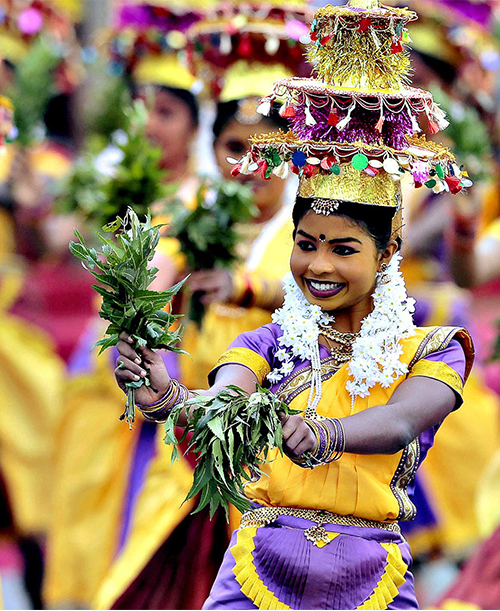
The Hindu festival of Maha Sivarathri, “The Great Night of Shiva”, is celebrated in late February or early March in Hindu homes and temples across the country. This is the most important religious festival of the year for Shaivites, who comprise the majority of Sri Lanka’s Hindus. It is a deeply symbolic occasion celebrating the charming of Lord Shiva by his consort Parvati through penance. Poojas are held at kovils during the day and can be witnessed by visitors.
April

Sri Lankan New Year, which occurs usually on the 13th and 14th of April, is a non-religious festival celebrated by both Sinhalese and Tamil people in Sri Lanka. Originally a harvest thanksgiving, it does not begin at midnight on the designated day, because, like many events in Sri Lanka, the precise (‘auspicious’) timings are decided upon astrologically.
It’s believed New Year commences not when the old one ends, but a few hours later. The interval between the old and the new is called nonagathe, or “neutral period”, during which all activities cease. When the New Year commences, fresh activities begin: a fire is lit for cooking and new clothes are worn. Then comes the ganu-denu, or “give and take” in which money is exchanged.
The festival culminates when oil is mixed with herbal paste and a respected elder anoints the head of each family member.
During the festive period traditional games, both indoor and outdoor, such as kotta pora (pillow fighting) and havari hengima (hiding the wig) are played at homes and villages. The festival and its rituals help to bring families and communities together.
May
The most important Buddhist full moon day is in May – Vesak Poya – which marks the Buddha’s birth, enlightenment and passing away (Pariniwana). Large pandals (bamboo frameworks) hung with pictures depicting events in the life of the Buddha are erected in the streets, illuminated by flashing coloured light bulbs. Roadside dansalas (stalls) offering free food and soft drinks to passers-by are notable features of the event. Among the many striking Vesak decorations are intricate paper lanterns of different shapes and sizes, and little clay coconut oil lamps (pol-thel pahana) that flicker throughout the island. Visitors to Sri Lanka at this time will not fail to witness and be moved by the beautiful displays of lanterns outside every Buddhist home, business and temple.
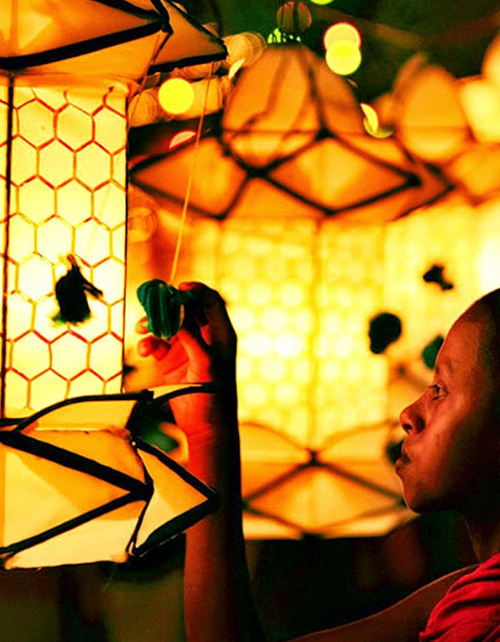
June
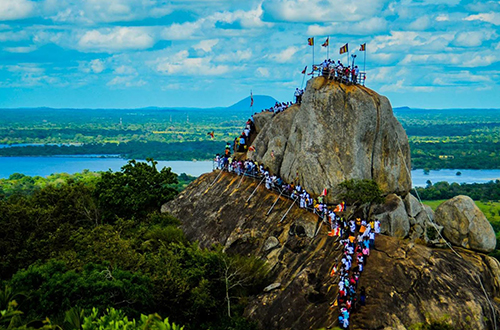
Poson Poya is second in importance to Vesak since it commemorates the introduction of Buddhism to Sri Lanka in 247BC. The focus of this festival is the ancient capital of the country. Anuradhapura, and the mountainous Mihintale Temple, reached by 1,840 steps. During Poson, the mountain is illuminated and devotees climb steps in their thousands to pay homage to the event.
July – August
Sri Lanka’s most prominent religious festival is the magnificent Kandy Esala Perahera.It is held in the hill capital of Kandy over 10 days in late July to early August and climaxing on Esala Poya.
The perahera’s origins date back to the third century BC, but the modern event originated in the mid – 18th century.
Today, thousands – including many visitors – flock to Kandy during this dazzling ten day festival, where,
the Maligawa Tusker carries the gold casket containing the relic accompanied by fellow elephants, human dancers ,touch bearers ,whippers etc.
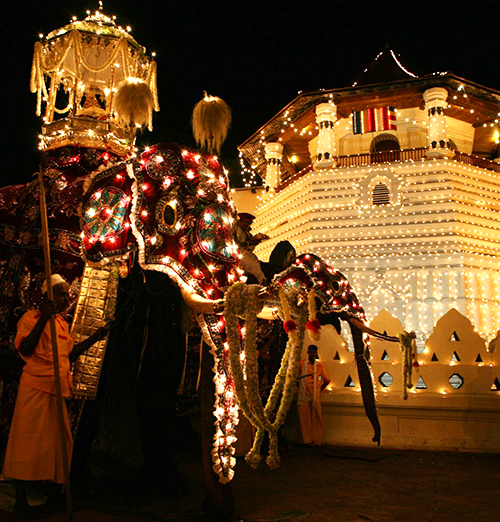
Sri Lanka’s most prominent religious festival is the magnificent Kandy Esala Perahera.It is held in the hill capital of Kandy over 10 days in late July to early August and climaxing on Esala Poya.
The perahera’s origins date back to the third century BC, but the modern event originated in the mid – 18th century.
Today, thousands – including many visitors – flock to Kandy during this dazzling ten day festival, where,
the Maligawa Tusker carries the gold casket containing the relic accompanied by fellow elephants, human dancers ,touch bearers ,whippers etc.
The air is filled with the pulsating throb of a multitude of drums, the ethereal-sounding wail of wind instruments, the wicked crack of whips, even the occasional trumpeting of an elephant. There is quieter participation too, from stilt walkers, acrobats, and the most aesthetically pleasing and traditionally important of all the performers, the dancers.
In the southeast of the island, the sacred site of Kataragama is brought to life with its unique annual Esala Festival,
The festival commemorates the victory the six-faced, 12-armed Hindu war god, Skanda.
Naturally, many Hindu devotees make the pilgrimage to the shrine, but Buddhists, Muslims and some Christians also honour this god. During this 10-day festival pilgrims demonstrate their sincerity by performing astonishing acts of penance and self-motivation. These include walking barefoot atop hot coals and spearing themselves with hooks.
At Dondra, Sri Lanka’s southernmost point, just five kilometers from Matara, a notable festival dedicated to Lord Vishnu featuring low-country dances, traditional rituals, a perahera and a handicrafts fair, is held in July. During the same month and commencing on the Easala Poya Day is a seven-day festival with a perahera in Unawatuna, near Galle, where devotees descend on the village and beach. At Bellanwila, just south of Colombo, another perahera takes place during the week-long poya festivities held at the historic Rajamaha Vihara.
Hindus celebrate a festival known as Vel in July to mark the triumph of Lord Murugan (another aspect of the war god Skanda) over evil powers. A magnificent silver-plated chariot bearing a statue of Lord Murugan leaves a kovil in the Pettah, a commercial district of Colombo, and is lead by procession to another kovil in Bambalapitiya, followed by musicians and devotees smashing coconuts and singing songs of praise to Lord Shiva. Along the route there are stalls selling sweet delicacies, souvenirs and handicrafts to passers-by.
The Munneswaram Temple, three kilometers from Chillaw, is another focus of celebration for Hindus in July as they celebrate with fire-walking in devotion to Lord Shiva while another small festival is held at the seaside shrine of Udappuwa.
The Nallur Festival in Jaffna in August is the island’s longest festival. Spanning 25 days of vibrant chariot processions, drumming, dancing and acts of self-mortification, held in honour of the war god Skanda.
The Festivities on the Beach are a rare occasion where a blend of music, art performances, kite festivals, surfing, beach parties, weddings and leisure activities take place. The magical experience on the beach will lift your spirits becoming a feast for your eyes ! come, and explore the wonder !
October – November

The Hindu festival Deepavali, the Festival of Lights, (known in India and elsewhere as Diwali) celebrates an aspect of the epic poem Ramayana – the homecoming of the Indian prince Rama,after a 14-year exile in the forest and his victory over Lanka’s King Ravana.
In the legend, the people welcomed Rama by lighting rows of lamps, and that’s exactly what is done today. Devotees all over the country wear new clothes and cook sweet dishes to propitiate the goddess of wealth, Lakshmi, who is also associated with the festival.
December
December brings the Sri Pada (Adam’s Peak) pilgrimage season.
Buddhist, Hindu, Muslim and Christian pilgrims climb the 2,234m mountain to a temple that bears the ‘footprint’ of the Buddha, Lord Shiva or Adam, according to the different religious beliefs. This is yet another example of how the different faiths in Sri Lanka share sacred sites and symbols harmoniously.
The climb begins from the village of Dalhousie shortly after midnight in order to reach the summit by sunrise, when a spectacular triangular shadow of the peak, known as the ira-sevaya or “service of the sun,” foreshortens in spectacular fashion.
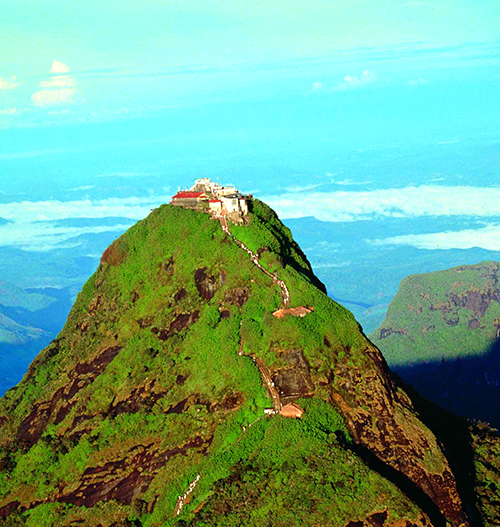
Uduwap Poya marks the planting of a sapling of the bo-tree — sri maha Bodiya – under which the Buddha gained enlightenment. Today it is one of the most sacred relics of Sri Lanka’s Buddhists and is considered to be the oldest documented living tree in the world. Devotees flock here to pray and to perform other religious rituals.
Muslim Festivals

Muslim festivals follow the Islamic lunar calendar. Having either 354 or 355 days in a year, the lunar calendar is shorter than the typical solar/ Gregorian calendar. This means that Islamic holy days retreat at a rate of between10 and12 days each successive solar year, and therefore have no fixed day. Each Muslim celebration typically includes prayers and sermons at the mosque, the distribution of alms and family-orientated celebrations. Muslim festivals are typically held without much public display and with little involvement outside of the Muslim community.
The most important festivals in Sri Lanka are:
- Milad Un Nabi or Prophet Mohammed’s birthday,
- Id Ul Fitr or the end of Ramadan,
- Id Ul Alha or the Hajj Festival day.
At Milad Un Nabi, Muslims celebrate the birth of the most important Prophet in Islam by listening to speeches about his life and his teachings.
Id Ul Fitr marks the end of Ramadan, the holy month of fasting, with festivities that often go on for three days.
The celebrations surrounding Id Ul Alha, a festival to commemorate Abraham’s willingness to sacrifice his son Ismail as an act of obedience to God, often go on for four days. During Id, Muslims recite special prayers, exchange gifts between families and friends and prepare special meat dishes that are shared with the poorer Muslim community.
Heritage
Sri Lanka contains an astonishing seven UNESCO World Heritage Sites. Six cultural sites are testament to a civilization with over 2,000 years of recorded history, while a seventh natural site boasts some of the highest biodiversity found outside the Amazon basin.
From colossal ancient monuments and serene rock carvings in sprawling ruined cities, to a 5th c. AD king’s palace in the clouds, the World Heritage Sites showcase the island’s rich history and contribution to civilization. The largest and most archeologically dramatic are located in the UNESCO-designated Cultural Triangle, the area formed by linking the ancient capitals of Anuradhapura, Polonnaruwa and Kandy. It’s a living heritage, where the visitor will see Buddhist monks and reverent devotees and hear the hypnotic murmur of religious invocations – all of which bring the brick temples, granite statues and towering dagobas of Sri Lanka’s ancient cities to life.
Through the heritage sites the visitor can relive some of the seminal episodes in the island’s past – the introduction of Buddhism, which inspired kings to undertake astounding feats of engineering; the complex palace intrigues; the repeated invasions and conquests; and ultimately, the capitulation to the European colonial powers.
Experiencing Sri Lanka’s heritage sites takes you on a spiritual journey that will uplift and amaze, inspire and refresh. The island’s compact dimensions mean that it is possible to combine a visit to several of these marvels in the Cultural Triangle during even the briefest of visits.
Sacred City of Anuradhapura
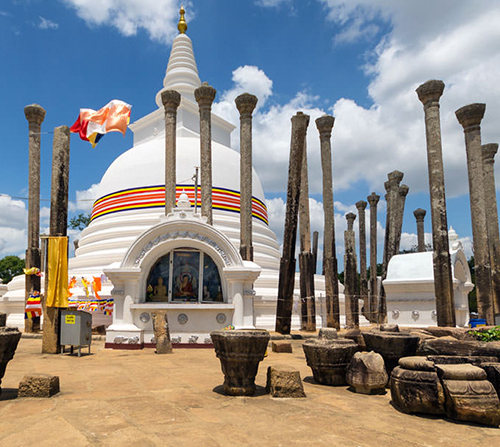
Located in the North Central Province, 206km from Colombo, the Sacred City of Anuradhapura is a magical place. Featuring some of the most ancient archaeological treasures in Sri Lanka, this vast heritage site is an impressive reminder of an ancient civilization.
Once one of the grandest monastic cities the world has ever seen, it was established in the 4th century BC, rising to prominence with the arrival of Buddhism, a pivotal event that saw the city transformed into a major centre of Buddhist pilgrimage and learning.
The great kings of Anuradhapura oversaw a golden age in the island’s history, building colossal dagobas that rivalled the pyramids of Egypt in scale. The city’s fame spread afar and features in writings from ancient Greece, Rome and China. But after enduring frequent invasions from South India, Anuradhapura eventually fell into decline in the 10th c. AD.
You feel overwhelmed at the scale of ancient Anuradhapura. At the centre of the ancient city is the Mahavihara, the oldest of the city’s monasteries. Worshippers still come to meditate here, drawn to the Sri Maha Bodhi, grown from the original tree under which the Buddha attained enlightenment in Northern India. The Thuparama dagoba, erected in the 3rd c. BC, was the first Dagoba to be built in Sri Lanka and enshrines the Buddha’s right collarbone. Standing before the red-brick Jetavana Dagoba – once the third tallest structure in the world – is an awesome experience. The Abhayagiri Dagoba is still covered in earth and vegetation, while the more famous Ruvanvalisaya Dagoba, fully restored, is beautifully illuminated at night. The magnificentKuttamPokuna or “twin baths” with their stone steps are well preserved but all that remains of the Brazen Palace – once a nine-storey structure with 1,000 rooms – is 1,600 granite columns. The Isurumuniya rocktemple houses a famous 5th c AD Indian-style sculpture known as the lovers.
Anuradhapura is nestled between three vast reservoirs known as tanks – the Basawakkulama, the Tissa Wewa and the Nuwara Wewa. Part of a sophisticated irrigation system developed from the 4th c. BC onwards, these still carry life-giving water to the fields in the dry zone, living testament to the engineering skills of the ancient rulers. The raised bunds of the tanks are perfect for an evening stroll and some bird-watching, while also offering great views of the city’s dagobas.
Medieval Capital of Polonnaruwa
In the 12th c. AD, the medieval capital of Polonnaruwa was one of the great urban centres in South Asia. Today, the well preserved ruins give you the chance to experience the grandeur of this period and marvel at the artistry of the island’s early craftsmen.
Located 142km from Colombo, Polonnaruwa was the island’s second ancient capital. Many of the existing ruins owe their construction to Parakramabahu the Great, the last in a sequence of warrior-kings, who developed the city on a lavish scale. He is also credited with the massive artificial lake that lies to the west of the city, the Sea of Parakrama.
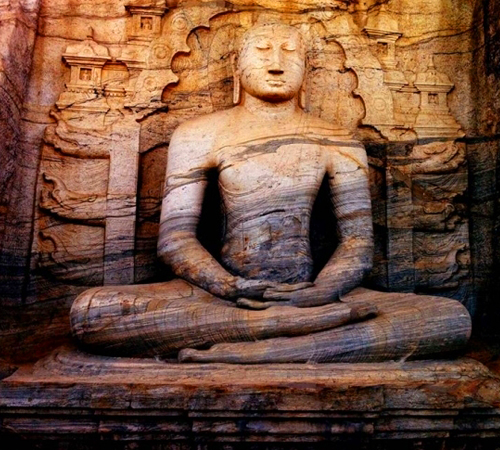
At the heart of the ancient city are the remains of the Royal Palace and Council Chamber. Nearby is the vatadage or relic house, a beautifully decorated circular structure with an uncanny resemblance to Stonehenge. Among the other sites are the gal pota(stone book) – a 9m-long granite slab inscribed with the feats of a king – the Lankatilaka shrine and the supremely graceful Buddha statues at Gal Vihara, the pinnacle of Sri Lankan rock carving. The site also hosts many distinctly South Indian-style Hindu temples.
Polonnaruwa’s ancient splendor cannot fail to inspire. Set amongst gently undulating woodland, the monkeys, giant lizards and birdlife in abundance seem tamer than elsewhere in the island. Even 1980’s pop group Duran Duran were obviously impressed, featuring Polonnaruwa in their music video, Save a Prayer.
Cave Temples of Dambulla
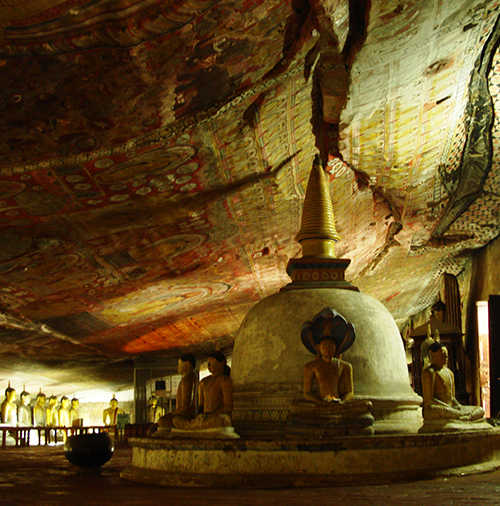
Hewninto a 160m granite outcrop are the remarkable cave temples of Dambulla. Located at the centre of the island, 148km from Colombo, and on the main route north to Anuradhapura and Polonnaruwa, the cave temples are masterpieces of Buddhist art. Each is filled with murals depicting scenes from the Buddha’s life, and glided statues of the Buddha in various poses.
In the 1st c. BC, the caves provided refuge to a king who fled a South Indian invasion. On reclaiming his throne, the grateful king had temples constructed in the caves that had sheltered him. These were embellished by subsequent rulers, especially during the Kandyan period in the 17th and 18th centuries.
Altogether, there are five caves, Cave 2, the Maharaja Vihara is the largest and most spectacular at over 50m long, 7m high and almost 25m deep. The spiritual energy at Dambulla is palpable and the Buddhist art on display is unparalleled in Sri Lanka. An added bonus is the majestic view from the top of the rock.
Sigiriya
Part hedonistic pleasure palace, part fortress and part sacred complex, Sigiriya is one of the island’s most awe-inspiring archaeological sites and a leading tourist attraction. In fact some consider it to be one of the oldest tourist attractions in the world with early visitors recording their impressions as graffiti on a wall described as the world’s first interactive book. Located north of Dambulla, 169km from Colombo, the site consists of a sheer rock that rises over 200m with the ruins of a palace on the top and a vast pleasure garden complex at the foot.
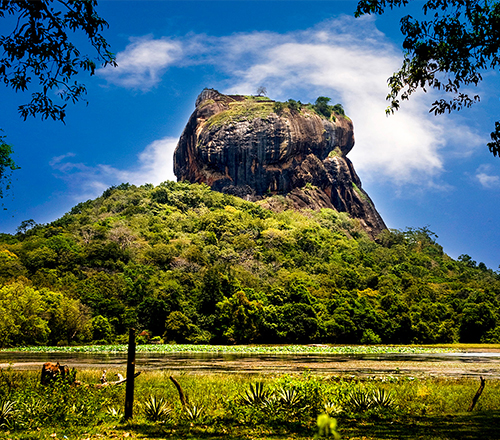
For just two decades in the 5th c. AD, Sigiriya rose to prominence following a power struggle between two brothers, and an act of patricide that saw the then king walled-up alive by his son, Kasyapa. Fearful that his defeated brother would return from exile to extract vengeance, Kasyapa shifted the capital to Sigiriya.
The megalomaniac yet spiritual Kasyapa clearly had an eye for beauty. The pleasure gardens include a series of symmetric pools, channels and fountains that still spurt water after 1,500 years. Partway up the rock are the famous Sigiriya frescoes, featuring 21 bare-breasted damsels that may represent celestial nymphs, but were surely modeled on Kasyapa’s own consorts. Halfway you’ll encounter a pair of giant lion’s paws, part of the original entrance, which required visitors to pass through the open mouth of a lion. The summit yields a dramatic vista of the surrounding jungle and contains the foundations of the palace complex, replete with bathing pool. But all this was to be in vain.
Kasyapa descended from his palace in the clouds to face his brother astride an elephant, eventually taking his own life when facing certain defeat.
Royal City of Kandy

Nestled amidst lush mountains in the north of the island’s hill country, the Royal City of Kandy, 116km from Colombo, was home to Sri Lanka’s last independent kingdom, surviving two centuries of colonial incursions by the Portuguese and the Dutch before falling to the British in 1815. The legacy of this proud tradition lives on today in the form of the city’s distinctive architecture, art and dance.
Home to the sacred relic of the tooth of the Buddha, a visit to the Dalada Maligawa or Temple of the Tooth, is an experience no tourist should miss. Said to have been snatched from the Buddha’s funeral pyre and smuggled to Sri Lanka in the hair of a princess, the tooth relic is of great spiritual significance. Each year in July or August is the Esala Perahera (perahera means “procession”), a spectacular display of medieval pageantry that includes caparisoned elephants, fire dancers and Kandyan drummers.
Stroll around the beautiful lake, the centerpiece of the town and explore the numerous temples perched on the hills – these are pleasant ways to spend your time in Kandy. Experiencing the pulsating drum rhythms and colourful traditional dances at a cultural show is another must, as is a ramble through the Royal Botanical Gardens at Peradeniya, 6km south of the city. Kandy is also the best place in Sri Lanka to study meditation.
Dutch Fort at Galle
The 17th c. Dutch Fort at Galle, close to the island’s southernmost point 173km from Colombo, has the distinction of being the best-preserved sea fort in South Asia. Enter through the imposing stone bastions that encircle the sea-facing promontory and step back in time. Inside the Fort you will find that it exudes old-world charm. The narrow streets are dotted with Dutch colonial villas and there’s a welcome absence of vehicular traffic. There are several museums and antique shops that display curiosities from the island’s colonial era. Of the many colonial buildings, perhaps the most absorbing is the Dutch Reformed Church, containing ornately carved memories to the city’s Dutch settlers. The Fort also hosts some of the island’s most exclusive boutique-style accommodation in former villas restored to their colonial glory.
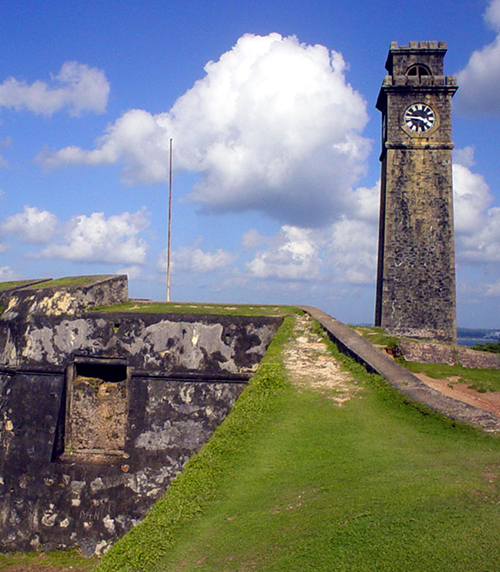
The Portuguese established the first fort in Galle. This was captured by the Dutch in 1640, after which the fortifications were expanded and the grid street system established. Further extensions were made during the British period. The passenger port gained importance, but with the construction of a breakwater at Colombo, Galle slipped into maritime decline.
Stroll along the massive ramparts at dusk. Experience the tranquil ambience of a bygone era yet see life as it proceeds: children flying kites, games of softball cricket, and couples canoodling behind the privacy of umbrellas. They all seem to enhance the magic of the Fort.
Sinharaja Forest Reserve
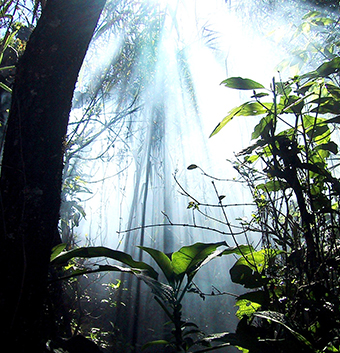
Damp, mysterious and teeming with life, the Sinharaja Forest Reserve, situated 120km south-east of Colombo, is the last extensive stretch of virgin rainforest on the island. At just over 11,000 hectares, lying across the wet zone at the southern edge of the hill country, Sinharaja is an ecological treasure trove. Its staggering array of flora and fauna place it among the top biodiversity hotspots in the world.
Over 130 bird species are found here including many of the 33 species endemic to Sri Lanka. There is also a rich reptile population and myriads of insect species, many yet to be classified. Mammals seen here include the purple faced langur monkey and the giant squirrel. Sinharaja is also home to the elusive leopard.
It is preferable to explore Sinharaja on foot, which makes for a truly authentic jungle experience. Starting points for visits are Deniyaya to the east or Kudawa to the north.
Hill Country
Mist –shrouded mountains, rolling tea plantations, cascading waterfalls and quaint hilltop villages –are some of the enchanting aspects of the hill country.
A short distance by car or r ail from Colombo, this region offers you the chance to escape into a world that scarcely seems possible in the tropics. With surreal landscapes, cool climes and a rich heritage, the hill country is a haven for nature lovers, hikers, adventure seekers and anybody simply in search of peace and tranquillity.
Royal City of Kandy

Nestled in lush green hills and built around a scenic lake, the Royal City of Kandy, at 500m above sea level, is the hub of any visit to the hill country. Kandy, a UNESCO World Heritage Site, was the last stronghold of resistance to colonial rule. Even today, Kandyans pride themselves on their distinctive architecture, music, dance and art. The showpiece of the city is the Dalada Maligawa or Temple of the Tooth, which hosts the Buddha’s sacred tooth relic.
Each year, in July or August, the city holds the Esala Perahera, a spectacular display of medieval pageantry replete with caparisoned elephants, whirling fire dancers and pulsating drummers.
The journey from Colombo to Kandy is a treat with fine views of the scenery afforded from the road or railway. Not to be missed Enroute is the Pinnawela Elephant Orphanage, where visitors can get up close and personal with over 60 pachyderms, ranging from cute babies and mischievous adolescents to majestic tuskers.
Just outside Kandy at Peradeniya, the Royal Botanical Gardens contains a bewildering array of local and foreign species set in a tranquil site adjacent to the mighty Mahaweli Ganga, Sri Lanka’s most important and longest river.
For many centuries, traders have been drawn to the island by the allure of its spices. Numerous spice gardens to the north of Kandy allow you to see how cinnamon, cloves, nutmeg, pepper and cardamom all continue to flourish in the island’s fertile soil.
Golfing enthusiasts should not miss the stunning Victoria Golf Course, set on the edge of a vast reservoir 20km east of Kandy.
Knuckles Mountain Range
Further east of Kandy, the Knuckles mountain range, a UNESCO World heritage site, provides fearless travellers with the opportunity to experience Sri Lanka at its most primal. A rugged area of pristine wilderness – including rare dwarf cloud forest – the Knuckles has 27 peaks over 1,000m, with the highest rising to nearly 2,000m.
It is also home to an exceptional array of endemic animal and plant species. Though largely uninhabited, the region contains some of the most isolated hamlets in the island, where it is still possible to witness a way of life largely untouched by modernity.
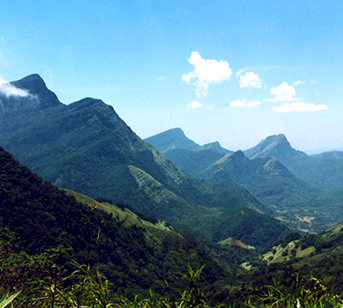
Nuwara-Eliya
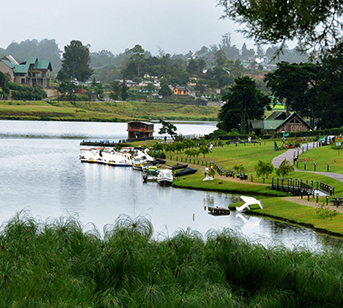
The heart of the southern hill country is Nuwara-Eliya; Sri Lanka’s highest town and a favourite hill station during British colonial times.
The town is still touted as “Little England” an illusion maintained by the presence of an 18-hole golf course, a racecourse, the Victoria Park and excellent trout fishing in nearby lakes and rivers.
The temperature in the area can drop to close to freezing at nights and it is common to see smoke rising from the chimneys of the many Tudor-style manors.
Nuwara-Eliya is a great base to explore the surrounding countryside and there are many walks on offer, including hiking around the lower slopes of the thickly forested Mount Pidurutalagala, at 2,555m the island’s highest peak. A visit to the Hakgala Botanical Gardens, a short distance from Nuwara-Eliya, is also recommended.
Tea Country
Among the most iconic vistas of the hill country are the rolling tea estates that carpet vast swathes of terrain in an emerald sea. Introduced to the island in the late 19th century by the British, tea remains of vital importance to the economy. Some of the finest teas in the world are produced in the hill country and a visit to a tea factory during a trip to this region is highly recommended.
Watch how the plucked tea is dried, crushed, fermented and fired using machinery that as remained largely unchanged since the Victorian times.

Horton Plains/Ella
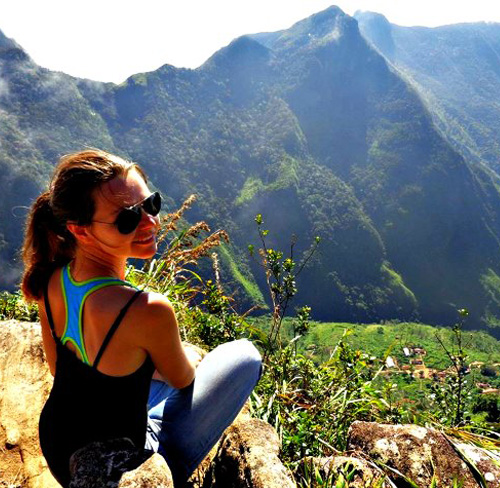
South of Nuwara-Eliya, the Horton Plains is a hauntingly desolate, windswept plateau set an elevation of over 2,000m.
A world apart from the rest of Sri Lanka, the plains offer excellent trekking, including a 9km circular walk to Worlds End, where the cliff plunges dramatically for nearly 1,000m, offering marvellous views to the south.
Herds of sambar deer, beautiful lizards and many endemic bird species enhance the Horton Plains experience and there is always the hope of a glimpse of a leopard.
Thrill- seekers will also find a range of activities such as canoeing and rock climbing on offer.
Perched on a hill side and surrounded by tea plantations and pine forest is the quaint village of Ella.
With pretty little bungalows and neat flower filled gardens, Ella is blessed with one of the finest views in Sri Lanka and makes a good location from which to explore other sites of interest.
Nearby is the ancient Ravana rock temple, the Ravana Ella cave and Ravana Ella falls, all linked by legend to the Ramayana, the 2,000-year-old Hindu epic. It was in Ella that the demon-king Ravana is said to have hidden Princess Sita after abducting her from her husband Rama in India.
From Ella, it is also possible to visit the remarkable rock carvings at Buduruwagala, one of the island’s most atmospheric ancient sites. Other hill country towns worth checking out include Haputale, Bandarawela and Badulla.
Train through the hill country
For visitors who are not in a hurry, riding the hill country on a train is an excellent way to savour the delights of this region.
Snaking its way through tea plantations, pine forests and plunging ravines, this is rightly regarded as one of the finest railway journeys in the world. Ascending to a height of over 2,000m, the journey affords stunning views of the scenery plus a chance to experience the romance of a mode of travel attuned to a bygone era.

Adam’s Peak (Sri Pada)

Soaring above the surrounding hills in the southwest of the hill country is Adam’s Peak. Known also as Sri Pada (Sacred Footprint) due to the curious footprint-shaped indentation at its summit.
The mountain is considered sacred to adherents of all Sri Lanka’s main faiths – Buddhists, Hindus, Muslims and Christians – and attracts many pilgrims between December and May each year.
The ascent requires stamina rather than mountaineering skills and consists of over 4,800 steps to the summit.
The best time to make the ascent is during the night, when the twinkling lights of the illuminated pathway appear to rise like stairway to heaven.
Dawn at the summit is an intensely spiritual experience. Pilgrims whisper reverently to each other as the sun rises and casts a perfect triangular shadow on the clouds below, one of the island’s more unusual natural phenomena.
Kitulgala
In the west of the hill country is the scenic village of Kitulgala. The landscape here is particularly dramatic with vertiginous forest-clad cliffs plummeting down to the wild waters of the Kelani River.
This is also the site of some of the best white water rafting in Sri Lanka with grade three rapids some 5km upstream.
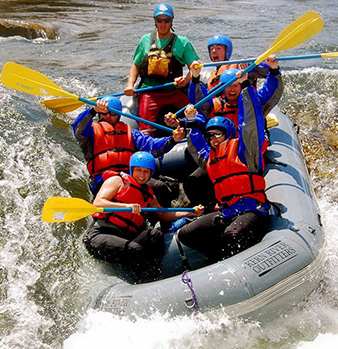
Ratnapura & Sinharaja Forest Reserve
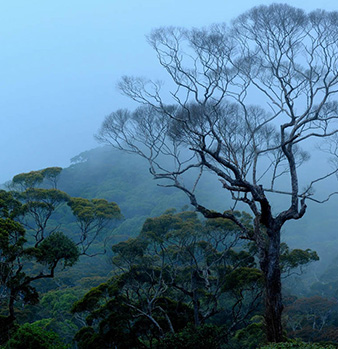
Sri Lanka has been famous for its gems since antiquity – legend has it that a Sri Lankan ruby was given by King Solomon to the Queen of Sheba.
Ratnapura, settled in the south-western corner of the hill country, is the island’s richest source of gems.
A trip to a working gem mine provides a fascinating glimpse into the mining process which is still largely carried out by hand.
Sinharaja Forest Reserve, a UNESCO World Heritage Site is the last extensive stretch of virgin rainforest on the island. Stretching for nearly 30km across the wet zone at the southern edge of the hill country, Sinharaja is a global biodiversity hotspot. Damp, mysterious and teeming with life, it is a must visit for those seeking an authentic jungle experience.
City
Lorem ipsum dolor sit amet, consectetur adipisicing elit, sed do eiusmod tempor incididunt ut labore et dolore magna aliqua. Ut enim ad minim veniam.
Duis aute irure dolor in reprehenderit in voluptate velit esse cillum dolore eu fugiat nulla pariatur. Excepteur sint occaecat cupidatat non proident, sunt in culpa. Ut enim ad minim veniam, quis trud tionco laboris nisi ut aliquip.
Colombo Sri Lanka‘s bustling commercial hub, is located on the country’s west coast and with a population of between 800,000 and one million (estimates vary) is by far the country’s biggest city, as well as the most developed. Its natural harbor at the mouth of the Kelani River was a magnet for successive traders and conquerors – initially the Arab merchants, then Portuguese, Dutch and British imperialists.
During your city tour you will visit places such as the Colombo Fort, Pettah Colombo, Dutch Period Museum, Galle Face Promenade, Museums, Independence Memorial Hall, Bandaranaike Memorial International Conference Hall (BMICH), Nelum Pokuna Mahinda Rajapaksa Theatre, Floating Market, Old Parliament, Religious sites, Colombo Lighthouse, Beira Lake, Viharamahadevi Park, Town Hall, University of Colombo, Colombo Racecourse.
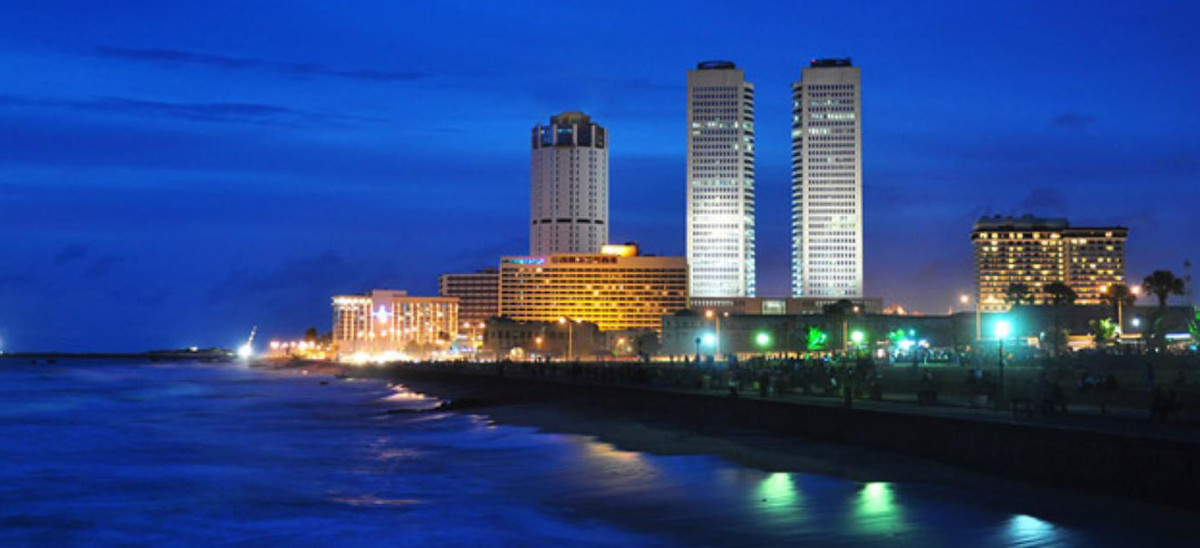
Kandy was first established by the King Wickramabahu (1357-1374 CE) near the Watapuluwa area, north of the present city, and it was named Senkadagalapura at the time, although some scholars suggest the name ‘Katubulu Nuwara’ may also have been used. The origin of the more popular name for the city, Senkadagala, could have been from a number of sources. These include naming it after a brahmin named Senkanda who lived in a cave near the city, after a queen of King Wickramabahu named Senkanda or after a coloured stone named Senkadagala. Temple of the Tooth Relic, Kandy Lake, Commonwealth war cemetery, religious sites, Victoria Golf
Resorts are some sites you can enjoy as well as you can enjoy cultural shows.
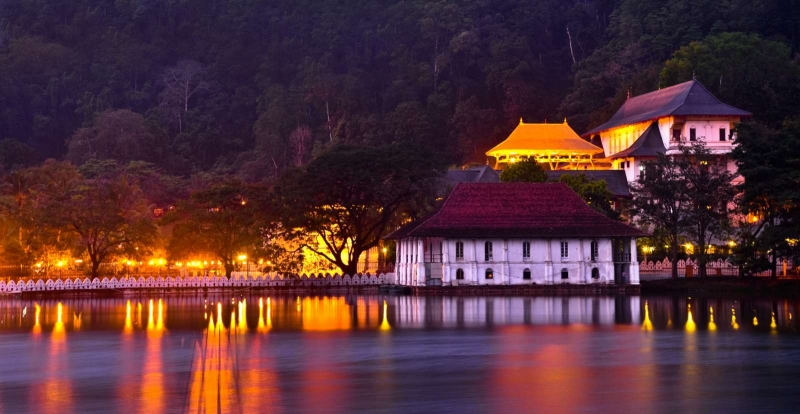
Nuwara Eliya is located 150 km away from Colombo in the Central Highlands of Sri Lanka and is known as ‘’Little England”. Nuwara Eliya which is at an elevation of 1890 meters above the sea level is the highest city in Sri Lanka and it lies beneath the tallest peak of the island, Pidurutalagala or Mount Pedro (2555 meters). The climate, the city, Victoria park, Race Course, Golf Course, Horton Plains and many waterfalls and other scenic areas which you would really enjoy.

Galle is a major city in Sri Lanka, situated on the southwestern tip, 119 km from Colombo. Galle is the administrative capital of Southern Province, Sri Lanka and is the district capital of Galle District. The seaside town of Galle is 116 Km away from Colombo by road or rail, down the south coast of Sri Lanka. Both routes are picturesque, following the coastline closely for much of the way. You can also take the Southern Expressway if you need to reach the city by half the time but there is not much scenery to admire. Old Town of Galle, National Maritime Museum, Dutch Reformed Church, Flag Rock and many other sites that you can peacefully enjoy.

Negombo is about 2 meters above sea level, and Negombo’s geography is a mix of land and water and a major tourist destination in Sri Lanka. This city is an ideal and liberal place with luxury, tropical life style, for those who want quick access to and from the country’s main international airport and also to Colombo city. The 100 km canal network running through the city is still used. Outrigger canoes and modern water-craft ply this route daily, for trade and tourism
